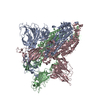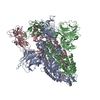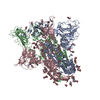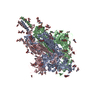[English] 日本語
 Yorodumi
Yorodumi- PDB-7p7b: SARS-CoV-2 spike protein in complex with sybody no68 in a 1up/2do... -
+ Open data
Open data
- Basic information
Basic information
| Entry | Database: PDB / ID: 7p7b | ||||||||||||
|---|---|---|---|---|---|---|---|---|---|---|---|---|---|
| Title | SARS-CoV-2 spike protein in complex with sybody no68 in a 1up/2down conformation | ||||||||||||
 Components Components | Spike glycoprotein | ||||||||||||
 Keywords Keywords | VIRAL PROTEIN / SARS-CoV-2 spike protein sybody | ||||||||||||
| Function / homology |  Function and homology information Function and homology informationsymbiont-mediated disruption of host tissue / Maturation of spike protein / Translation of Structural Proteins / Virion Assembly and Release / host cell surface / viral translation / host extracellular space / symbiont-mediated-mediated suppression of host tetherin activity / Induction of Cell-Cell Fusion / structural constituent of virion ...symbiont-mediated disruption of host tissue / Maturation of spike protein / Translation of Structural Proteins / Virion Assembly and Release / host cell surface / viral translation / host extracellular space / symbiont-mediated-mediated suppression of host tetherin activity / Induction of Cell-Cell Fusion / structural constituent of virion / membrane fusion / entry receptor-mediated virion attachment to host cell / Attachment and Entry / host cell endoplasmic reticulum-Golgi intermediate compartment membrane / positive regulation of viral entry into host cell / receptor-mediated virion attachment to host cell / host cell surface receptor binding / symbiont-mediated suppression of host innate immune response / receptor ligand activity / endocytosis involved in viral entry into host cell / fusion of virus membrane with host plasma membrane / fusion of virus membrane with host endosome membrane / viral envelope / symbiont entry into host cell / virion attachment to host cell / SARS-CoV-2 activates/modulates innate and adaptive immune responses / host cell plasma membrane / virion membrane / identical protein binding / membrane / plasma membrane Similarity search - Function | ||||||||||||
| Biological species |  | ||||||||||||
| Method | ELECTRON MICROSCOPY / single particle reconstruction / cryo EM / Resolution: 3.13 Å | ||||||||||||
 Authors Authors | Walter, J.D. / Hutter, C.A.J. / Garaeva, A.A. / Scherer, M. / Zimmermann, I. / Wyss, M. / Rheinberger, J. / Ruedin, Y. / Earp, J.C. / Egloff, P. ...Walter, J.D. / Hutter, C.A.J. / Garaeva, A.A. / Scherer, M. / Zimmermann, I. / Wyss, M. / Rheinberger, J. / Ruedin, Y. / Earp, J.C. / Egloff, P. / Sorgenfrei, M. / Huerlimann, L.M. / Gonda, I. / Meier, G. / Remm, S. / Thavarasah, S. / Zimmer, G. / Slotboom, D.J. / Paulino, C. / Plattet, P. / Seeger, M.A. | ||||||||||||
| Funding support |  Netherlands, Netherlands,  Switzerland, 3items Switzerland, 3items
| ||||||||||||
 Citation Citation |  Journal: EMBO Rep / Year: 2022 Journal: EMBO Rep / Year: 2022Title: Biparatopic sybodies neutralize SARS-CoV-2 variants of concern and mitigate drug resistance. Authors: Justin D Walter / Melanie Scherer / Cedric A J Hutter / Alisa A Garaeva / Iwan Zimmermann / Marianne Wyss / Jan Rheinberger / Yelena Ruedin / Jennifer C Earp / Pascal Egloff / Michèle ...Authors: Justin D Walter / Melanie Scherer / Cedric A J Hutter / Alisa A Garaeva / Iwan Zimmermann / Marianne Wyss / Jan Rheinberger / Yelena Ruedin / Jennifer C Earp / Pascal Egloff / Michèle Sorgenfrei / Lea M Hürlimann / Imre Gonda / Gianmarco Meier / Sille Remm / Sujani Thavarasah / Geert van Geest / Rémy Bruggmann / Gert Zimmer / Dirk J Slotboom / Cristina Paulino / Philippe Plattet / Markus A Seeger /   Abstract: The ongoing COVID-19 pandemic represents an unprecedented global health crisis. Here, we report the identification of a synthetic nanobody (sybody) pair, Sb#15 and Sb#68, that can bind simultaneously ...The ongoing COVID-19 pandemic represents an unprecedented global health crisis. Here, we report the identification of a synthetic nanobody (sybody) pair, Sb#15 and Sb#68, that can bind simultaneously to the SARS-CoV-2 spike RBD and efficiently neutralize pseudotyped and live viruses by interfering with ACE2 interaction. Cryo-EM confirms that Sb#15 and Sb#68 engage two spatially discrete epitopes, influencing rational design of bispecific and tri-bispecific fusion constructs that exhibit up to 100- and 1,000-fold increase in neutralization potency, respectively. Cryo-EM of the sybody-spike complex additionally reveals a novel up-out RBD conformation. While resistant viruses emerge rapidly in the presence of single binders, no escape variants are observed in the presence of the bispecific sybody. The multivalent bispecific constructs further increase the neutralization potency against globally circulating SARS-CoV-2 variants of concern. Our study illustrates the power of multivalency and biparatopic nanobody fusions for the potential development of therapeutic strategies that mitigate the emergence of new SARS-CoV-2 escape mutants. #1:  Journal: bioRxiv / Year: 2020 Journal: bioRxiv / Year: 2020Title: Bispecific sybody constructs neutralize SARS-CoV-2 variants of concern and mitigate emergence of drug-resistance Authors: Walter, J.D. / Hutter, C.A.J. / Garaeva, A.A. / Scherer, M. / Zimmermann, I. / Wyss, M. / Rheinberger, J. / Ruedin, Y. / Earp, J.C. / Egloff, P. / Sorgenfrei, M. / Huerlimann, L.M. / Gonda, ...Authors: Walter, J.D. / Hutter, C.A.J. / Garaeva, A.A. / Scherer, M. / Zimmermann, I. / Wyss, M. / Rheinberger, J. / Ruedin, Y. / Earp, J.C. / Egloff, P. / Sorgenfrei, M. / Huerlimann, L.M. / Gonda, I. / Meier, G. / Remm, S. / Thavarasah, S. / Zimmer, G. / Slotboom, D.J. / Paulino, C. / Plattet, P. / Seeger, M.A. | ||||||||||||
| History |
|
- Structure visualization
Structure visualization
| Movie |
 Movie viewer Movie viewer |
|---|---|
| Structure viewer | Molecule:  Molmil Molmil Jmol/JSmol Jmol/JSmol |
- Downloads & links
Downloads & links
- Download
Download
| PDBx/mmCIF format |  7p7b.cif.gz 7p7b.cif.gz | 565.8 KB | Display |  PDBx/mmCIF format PDBx/mmCIF format |
|---|---|---|---|---|
| PDB format |  pdb7p7b.ent.gz pdb7p7b.ent.gz | 456.8 KB | Display |  PDB format PDB format |
| PDBx/mmJSON format |  7p7b.json.gz 7p7b.json.gz | Tree view |  PDBx/mmJSON format PDBx/mmJSON format | |
| Others |  Other downloads Other downloads |
-Validation report
| Summary document |  7p7b_validation.pdf.gz 7p7b_validation.pdf.gz | 1.3 MB | Display |  wwPDB validaton report wwPDB validaton report |
|---|---|---|---|---|
| Full document |  7p7b_full_validation.pdf.gz 7p7b_full_validation.pdf.gz | 1.3 MB | Display | |
| Data in XML |  7p7b_validation.xml.gz 7p7b_validation.xml.gz | 89.3 KB | Display | |
| Data in CIF |  7p7b_validation.cif.gz 7p7b_validation.cif.gz | 134.1 KB | Display | |
| Arichive directory |  https://data.pdbj.org/pub/pdb/validation_reports/p7/7p7b https://data.pdbj.org/pub/pdb/validation_reports/p7/7p7b ftp://data.pdbj.org/pub/pdb/validation_reports/p7/7p7b ftp://data.pdbj.org/pub/pdb/validation_reports/p7/7p7b | HTTPS FTP |
-Related structure data
| Related structure data |  7p77C  7p78C  7p79C  7p7aC M: map data used to model this data C: citing same article ( |
|---|---|
| Similar structure data |
- Links
Links
- Assembly
Assembly
| Deposited unit | 
|
|---|---|
| 1 |
|
- Components
Components
| #1: Protein | Mass: 142427.438 Da / Num. of mol.: 3 Source method: isolated from a genetically manipulated source Source: (gene. exp.)  Gene: S, 2 / Production host:  Homo sapiens (human) / References: UniProt: P0DTC2 Homo sapiens (human) / References: UniProt: P0DTC2Has protein modification | Y | |
|---|
-Experimental details
-Experiment
| Experiment | Method: ELECTRON MICROSCOPY |
|---|---|
| EM experiment | Aggregation state: PARTICLE / 3D reconstruction method: single particle reconstruction |
- Sample preparation
Sample preparation
| Component | Name: SARS-CoV-2 spike protein / Type: COMPLEX / Entity ID: all / Source: RECOMBINANT |
|---|---|
| Source (natural) | Organism:  |
| Source (recombinant) | Organism:  Homo sapiens (human) Homo sapiens (human) |
| Buffer solution | pH: 8 / Details: 2 mM Tris-HCl pH 8.0, 200 mM NaCl |
| Specimen | Conc.: 0.7 mg/ml / Embedding applied: NO / Shadowing applied: NO / Staining applied: NO / Vitrification applied: YES |
| Specimen support | Details: at 5 mA / Grid material: GOLD / Grid mesh size: 300 divisions/in. / Grid type: Quantifoil R1.2/1.3 |
| Vitrification | Instrument: FEI VITROBOT MARK IV / Cryogen name: ETHANE-PROPANE / Humidity: 100 % / Chamber temperature: 288 K |
- Electron microscopy imaging
Electron microscopy imaging
| Experimental equipment |  Model: Talos Arctica / Image courtesy: FEI Company |
|---|---|
| Microscopy | Model: FEI TALOS ARCTICA |
| Electron gun | Electron source:  FIELD EMISSION GUN / Accelerating voltage: 200 kV / Illumination mode: FLOOD BEAM FIELD EMISSION GUN / Accelerating voltage: 200 kV / Illumination mode: FLOOD BEAM |
| Electron lens | Mode: BRIGHT FIELD / Nominal magnification: 130000 X / Calibrated magnification: 49407 X / Nominal defocus max: 2000 nm / Nominal defocus min: 300 nm / Calibrated defocus min: 300 nm / Calibrated defocus max: 2000 nm / Cs: 2.7 mm / C2 aperture diameter: 100 µm / Alignment procedure: COMA FREE |
| Specimen holder | Cryogen: NITROGEN / Specimen holder model: FEI TITAN KRIOS AUTOGRID HOLDER / Temperature (max): 105 K / Temperature (min): 90 K |
| Image recording | Average exposure time: 9 sec. / Electron dose: 53 e/Å2 / Detector mode: COUNTING / Film or detector model: GATAN K2 SUMMIT (4k x 4k) / Num. of grids imaged: 1 / Num. of real images: 5109 |
| EM imaging optics | Energyfilter name: GIF Bioquantum / Energyfilter slit width: 20 eV |
| Image scans | Width: 3838 / Height: 3710 / Movie frames/image: 60 / Used frames/image: 1-60 |
- Processing
Processing
| Software | Name: PHENIX / Version: 1.19.1_4122: / Classification: refinement | ||||||||||||||||||||||||||||||||||||||||||||||||||
|---|---|---|---|---|---|---|---|---|---|---|---|---|---|---|---|---|---|---|---|---|---|---|---|---|---|---|---|---|---|---|---|---|---|---|---|---|---|---|---|---|---|---|---|---|---|---|---|---|---|---|---|
| EM software |
| ||||||||||||||||||||||||||||||||||||||||||||||||||
| CTF correction | Type: PHASE FLIPPING AND AMPLITUDE CORRECTION | ||||||||||||||||||||||||||||||||||||||||||||||||||
| Particle selection | Num. of particles selected: 344976 | ||||||||||||||||||||||||||||||||||||||||||||||||||
| Symmetry | Point symmetry: C1 (asymmetric) | ||||||||||||||||||||||||||||||||||||||||||||||||||
| 3D reconstruction | Resolution: 3.13 Å / Resolution method: FSC 0.143 CUT-OFF / Num. of particles: 84917 / Algorithm: BACK PROJECTION / Symmetry type: POINT | ||||||||||||||||||||||||||||||||||||||||||||||||||
| Atomic model building | Space: REAL | ||||||||||||||||||||||||||||||||||||||||||||||||||
| Atomic model building | PDB-ID: 6ZGG Accession code: 6ZGG / Source name: PDB / Type: experimental model | ||||||||||||||||||||||||||||||||||||||||||||||||||
| Refine LS restraints |
|
 Movie
Movie Controller
Controller













 PDBj
PDBj




